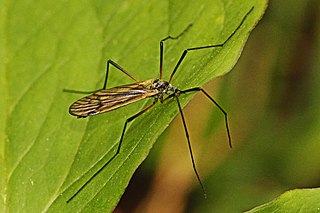
The Planctomycetota are a phylum of widely distributed bacteria, occurring in both aquatic and terrestrial habitats. They play a considerable role in global carbon and nitrogen cycles, with many species of this phylum capable of anaerobic ammonium oxidation, also known as anammox. Many Planctomycetota occur in relatively high abundance as biofilms, often associating with other organisms such as macroalgae and marine sponges.

Limnophila aromatica, the rice paddy herb, is a tropical flowering plant in the family Plantaginaceae. It is native to Southeast Asia, where it flourishes in hot temperatures and grows most often in watery environments, particularly in flooded rice fields. It is called ngò ôm or ngò om or ngổ in Vietnam and used as an herb and also cultivated for use as an aquarium plant. The plant was introduced to North America in the 1970s due to Vietnamese immigration following the Vietnam War. It is called "ma om" (ម្អម) in Khmer. It is used in traditional Cambodian soup dishes and Southern Vietnamese cuisine. It can grow in flooded rice paddies during wet season but it grows best on drained but still wet sandy soil of harvested rice paddies for a few months after the rainy season ended. It dies out soon after it flowers. Rural Cambodians often harvest them and put them on the roof of their houses to dry for later use.

Limnophila sessiliflora, known as dwarf ambulia, ambulis, and Asian marshweed is a flowering plant in the family Plantaginaceae.

Limnophila aquatica, known commonly as the giant ambulia, is a plant belonging to the family Plantaginaceae. Limnophila aquatica grows naturally in Asia, Sri Lanka and India and is characterised by its fine leaves and bushy, pine-like appearance. It grows best in medium or very high lighting, preferably in acidic soil. It can grow to a height of 9-20 inches, and its width can vary from 3-6 inches.

Limnophila is a genus of flowering plants in the family Plantaginaceae. It is distributed in tropical and subtropical regions of Africa, Asia, Australia, and the Pacific Islands. Species are known commonly as marshweeds.
Crypteria is a genus of crane fly in the family Limoniidae.

Limnophila is a genus of limoniid crane flies in the family Limoniidae. There are at least 280 described species in Limnophila.
Rennera is a genus of South African flowering plants in the daisy family.
L. japonica may refer to:

Hot and sour soup is a popular example of Chinese cuisine. Although it is said to be originated in Sichuan, this is actually a variant of hulatang or "pepper hot soup" (胡辣汤) with added vinegar to enhance the sourness. This variation is found in Henan province, and in Henan cuisine itself. Also popular in Southeast Asia, India, Pakistan and the United States, it is a flexible soup which allows ingredients to be substituted or added depending on availability. For example, the American-Chinese version can be thicker as it commonly includes corn starch, whilst in Japan, sake is often added.

Limnophila rufibasis is a species of limoniid crane fly in the family Limoniidae.
Limnophila marchandi is a species of limoniid crane fly in the family Limoniidae.

Limnophila macrocera is a species of limoniid crane fly in the family Limoniidae.
Limnophila fuscovaria is a species of limoniid crane fly in the family Limoniidae.
Limnophila angustula is a species of limoniid crane fly in the family Limoniidae.









